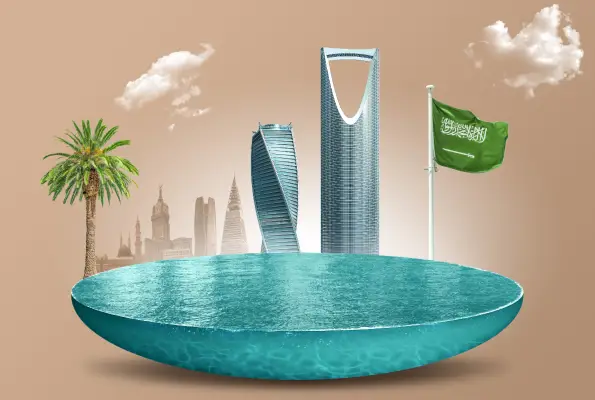Let’s cut to the chase. The Middle East is running out of water, fast. By 2050, the region’s demand will rise by another 25 billion cubic metres every year. That is the equivalent of sixty new Ras Al-Khair desalination plants. Saudi Arabia, the richest desert on Earth, has barely 89 cubic metres of renewable water per person, about one-tenth of the global average. Oil made the desert bloom once. Now technology will have to do it again.
Desalination remains the region’s lifeline and its biggest paradox. It is the technology that saves the Gulf region, but also one of the most energy-hungry processes on the planet. Yet that is changing. Sixty-nine large-scale desal projects worth around USD 65 billion are now under construction across MENA.
Reverse osmosis, once a power-guzzler, has gone on an energy diet, falling from 20 kWh per cubic metre in the 1980s to under 4 kWh today. Saudi Arabia’s 600,000 m³-per-day Jubail 3A plant will even run on solar, producing water using sunlight in one of the driest places on Earth. Sensors, AI, and predictive algorithms now do what human engineers cannot. They detect membrane fouling before it happens, dose chemicals precisely, and squeeze efficiency from every drop.
But desalination alone will not save the region. Wastewater reuse is where the real revolution lies. Abu Dhabi’s 2021 “Recycled Water and Biosolids Regulations” put a price on wastewater and value in it. Farmers and industries now get tariffs that reward them for using treated effluent.
Dubai plans to recycle 100% of its wastewater by 2030. Jordan’s As-Samra plant already treats 70% of the country’s sewage and runs mostly on its own biogas. Egypt’s New Delta project, producing 7 million cubic metres a day, turns waste into fertiliser. The message is simple. In the new Middle East, water is no longer wasted; it is mined.
Agriculture remains the elephant in the desert. Farming consumes more than 80% of MENA’s (Middle East and North Africa) water, and that is where startups are stepping in. Jordan’s SmartWTI has built IoT-driven irrigation systems that can read soil like a doctor reads a patient, checking salinity, moisture, and temperature before releasing just the right amount of water.
The result is healthier crops, smaller bills, and far less waste. The UAE’s Masdar City uses AI analytics to fine-tune watering schedules, while scientists race to gene-edit crops that can survive heat waves that would cook most plants alive.
This wave of innovation is not theoretical. It is local, tangible, and, crucially, investable. UAE-based Manhat has patented a solar-powered floating distiller that pulls pure water out of the sea without discharging brine back into it. Other startups are tapping the air itself, using humidity condensers to pull water from thin air.
Governments are finally backing these innovators, not with slogans but with money. The Mohammed bin Rashid Innovation Fund bankrolls cleantech entrepreneurs. The Saudi Public Investment Fund (PIF) is quietly placing bets on deep-tech water ventures. And at COP28, Riyadh’s International Water Research Centre launched with KAUST to anchor R&D in desalination and digital water systems.
Of course, none of this comes cheap. The MENA water sector faces a USD 110 billion funding gap, a number as vast as the desert itself. So, the money game is changing too. Green bonds are the new lifelines.
Egypt led the Arab world with a USD 750 million green bond in 2020, funding water and energy projects at lower interest rates thanks to ESG demand. Public-Private Partnerships are spreading fast.
Saudi Arabia alone has more than forty water PPP projects worth over USD 700 million. Sovereign wealth funds, the same ones that bankroll football clubs and gaming giants, are now underwriting desalination and water grids. Even Islamic finance is getting a green makeover, with sukuk issues tied to water and energy sustainability.
The stakes could not be higher. In 2023, over USD 20 billion in water contracts were awarded in MENA, and nearly three-quarters of that was in Saudi Arabia. No government can pay its way out of drought; it must innovate its way out. Water scarcity is not just an environmental crisis; it is the region’s biggest economic opportunity since oil.
Twelve of the world’s seventeen most water-stressed countries sit in MENA, yet the region is quietly building a global export industry in desalination, wastewater reuse, and smart irrigation. From AI-driven farms to zero-brine solar stills, water is no longer a liability; it is an asset class. The Middle East may have been built on black gold, but its next boom will be blue.



